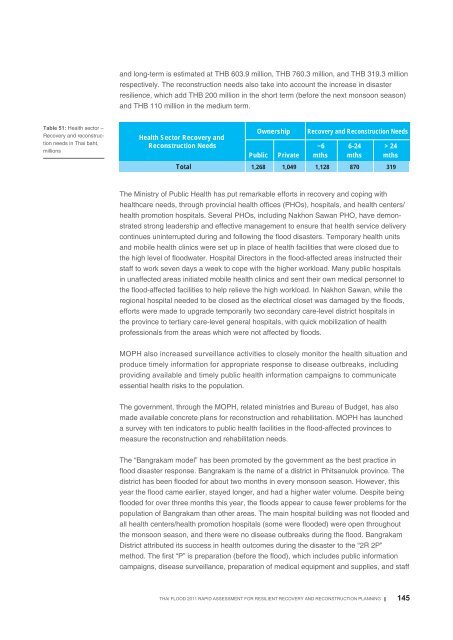Rapid Assessment for Resilient Recovery and ... - GFDRR
Rapid Assessment for Resilient Recovery and ... - GFDRR
Rapid Assessment for Resilient Recovery and ... - GFDRR
Create successful ePaper yourself
Turn your PDF publications into a flip-book with our unique Google optimized e-Paper software.
<strong>and</strong> long-term is estimated at THB 603.9 million, THB 760.3 million, <strong>and</strong> THB 319.3 million<br />
respectively. The reconstruction needs also take into account the increase in disaster<br />
resilience, which add THB 200 million in the short term (be<strong>for</strong>e the next monsoon season)<br />
<strong>and</strong> THB 110 million in the medium term.<br />
Table 51: Health sector –<br />
<strong>Recovery</strong> <strong>and</strong> reconstruction<br />
needs in Thai baht,<br />
millions<br />
Health Sector <strong>Recovery</strong> <strong>and</strong><br />
Reconstruction Needs<br />
Ownership<br />
Public<br />
Private<br />
<strong>Recovery</strong> <strong>and</strong> Reconstruction Needs<br />
~6<br />
mths<br />
6-24<br />
mths<br />
> 24<br />
mths<br />
Total 1,268 1,049 1,128 870 319<br />
The Ministry of Public Health has put remarkable ef<strong>for</strong>ts in recovery <strong>and</strong> coping with<br />
healthcare needs, through provincial health offices (PHOs), hospitals, <strong>and</strong> health centers/<br />
health promotion hospitals. Several PHOs, including Nakhon Sawan PHO, have demonstrated<br />
strong leadership <strong>and</strong> effective management to ensure that health service delivery<br />
continues uninterrupted during <strong>and</strong> following the flood disasters. Temporary health units<br />
<strong>and</strong> mobile health clinics were set up in place of health facilities that were closed due to<br />
the high level of floodwater. Hospital Directors in the flood-affected areas instructed their<br />
staff to work seven days a week to cope with the higher workload. Many public hospitals<br />
in unaffected areas initiated mobile health clinics <strong>and</strong> sent their own medical personnel to<br />
the flood-affected facilities to help relieve the high workload. In Nakhon Sawan, while the<br />
regional hospital needed to be closed as the electrical closet was damaged by the floods,<br />
ef<strong>for</strong>ts were made to upgrade temporarily two secondary care-level district hospitals in<br />
the province to tertiary care-level general hospitals, with quick mobilization of health<br />
professionals from the areas which were not affected by floods.<br />
MOPH also increased surveillance activities to closely monitor the health situation <strong>and</strong><br />
produce timely in<strong>for</strong>mation <strong>for</strong> appropriate response to disease outbreaks, including<br />
providing available <strong>and</strong> timely public health in<strong>for</strong>mation campaigns to communicate<br />
essential health risks to the population.<br />
The government, through the MOPH, related ministries <strong>and</strong> Bureau of Budget, has also<br />
made available concrete plans <strong>for</strong> reconstruction <strong>and</strong> rehabilitation. MOPH has launched<br />
a survey with ten indicators to public health facilities in the flood-affected provinces to<br />
measure the reconstruction <strong>and</strong> rehabilitation needs.<br />
The “Bangrakam model” has been promoted by the government as the best practice in<br />
flood disaster response. Bangrakam is the name of a district in Phitsanulok province. The<br />
district has been flooded <strong>for</strong> about two months in every monsoon season. However, this<br />
year the flood came earlier, stayed longer, <strong>and</strong> had a higher water volume. Despite being<br />
flooded <strong>for</strong> over three months this year, the floods appear to cause fewer problems <strong>for</strong> the<br />
population of Bangrakam than other areas. The main hospital building was not flooded <strong>and</strong><br />
all health centers/health promotion hospitals (some were flooded) were open throughout<br />
the monsoon season, <strong>and</strong> there were no disease outbreaks during the flood. Bangrakam<br />
District attributed its success in health outcomes during the disaster to the “2R 2P”<br />
method. The first “P” is preparation (be<strong>for</strong>e the flood), which includes public in<strong>for</strong>mation<br />
campaigns, disease surveillance, preparation of medical equipment <strong>and</strong> supplies, <strong>and</strong> staff<br />
THAI FLOOD 2011 RAPID ASSESSMENT FOR RESILIENT RECOVERY AND RECONSTRUCTION PLANNING<br />
145

















